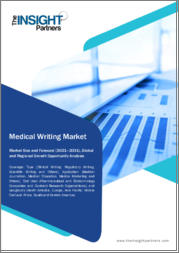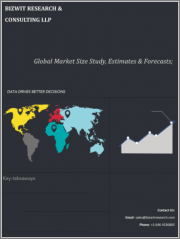
|
시장보고서
상품코드
1749704
세계의 메디컬 라이팅(MW) 분야 AI 시장 : 유형별·전개 방식별·최종 용도별, 지역별 평가, 기회와 예측(2018-2032년)Global AI in Medical Writing Market Assessment, By Type, By Deployment Mode, By End-use, By Region, Opportunities and Forecast, 2018-2032F |
||||||
세계 메디컬 라이팅(MW) 분야 AI 시장은 2025-2032년의 예측 기간 동안 연평균 11.61%의 연평균 복합 성장률(CAGR)을 나타내고, 2024년 8억 4,542만 달러에서 2032년 20억 3,505만 달러에 달할 것으로 예측됩니다. 시장의 성장은 규제 문서, 과학 출판물, 임상 연구 증가, 생성형 AI에 대한 의존도 증가, 반복적인 작업을 간소화하고 인적 오류 발생을 줄이기 위해 다양한 의료 프로세스에 신기술을 통합하는 데 대한 관심이 높아졌기 때문일 수 있습니다.
세계 규제 당국은 AI를 통한 문서화를 점차 수용하고 있으며, AI는 여러 저자가 관여하는 경우에도 제출 서류의 섹션 간 일관성을 보장하고, 팀이 문서의 무결성을 유지할 수 있도록 돕고 있습니다. 지원합니다. 임상 문서 작성을 위한 플러그 앤 플레이 솔루션을 제공하는 AI 플랫폼이 등장함에 따라, 작문 팀을 확대하지 않고도 촉박한 기한을 충족해야 하는 중견 CRO와 제약회사에서 AI 플랫폼의 채택이 가속화되고 있습니다. AI 툴을 전자 데이터 수집(EDC) 및 임상시험 마스터 파일(TMF) 시스템과 통합된 AI 툴을 통해 기업은 소스에서 제출까지의 데이터 흐름을 자동화할 수 있습니다.
의료 작문 분야에서 다양한 AI 도구에 대한 인식과 수용도가 높아짐에 따라 전 세계 AI 기업들은 연구 지원을 제공하는 새로운 모델을 출시하여 과학 컨텐츠 제작 워크플로우를 혁신하고 있습니다. 예를 들어, 2024년 11월 AINGENS, LLC는 인용 지원, 편집, 참고 문헌 관리를 제공하는 AI 기반 의료 작문 도구인 MACg(Medical Affairs Content Generator)를 발표했습니다.
목차
제1장 프로젝트의 범위와 정의
제2장 분석 방법
제3장 미국 관세의 영향
제4장 주요 요약
제5장 세계의 메디컬 라이팅(MW) 분야 AI 시장 전망(2018-2032년)
- 시장 규모 분석과 예측
- 금액 기준
- 시장 점유율 분석과 예측
- 유형별
- 임상 문서 작성
- 규제 문서 작성
- 환자 기록
- 과학논문 집필
- 전개 방식별
- On-Premise
- 클라우드 기반
- 최종 용도별
- 의료기기 기업
- 제약 기업 및 바이오테크놀러지 기업
- 학술연구기관
- 기타
- 지역별
- 북미
- 유럽
- 아시아태평양
- 남미
- 중동 및 아프리카
- 시장 점유율 분석 : 기업별(주요 5개사 및 기타, 금액 기준, 2024년)
- 유형별
- 시장 맵 분석(2024년)
- 유형별
- 전개 방식별
- 최종 용도별
- 지역별
제6장 북미의 메디컬 라이팅(MW) 분야 AI 시장 전망(2018-2032년)
- 시장 규모 분석과 예측
- 금액 기준
- 시장 점유율 분석과 예측
- 유형별
- 임상 문서 작성
- 규제 문서 작성
- 환자 기록
- 과학논문 집필
- 전개 방식별
- On-Premise
- 클라우드 기반
- 최종 용도별
- 의료기기 기업
- 제약 기업 및 바이오테크놀러지 기업
- 학술연구기관
- 기타
- 국가별 점유율
- 미국
- 캐나다
- 멕시코
- 유형별
- 국가별 시장 평가
- 미국의 메디컬 라이팅(MW) 분야 AI 시장 전망(2018-2032년)*
- 시장 규모 분석과 예측
- 시장 점유율 분석과 예측
- 캐나다
- 멕시코
- 미국의 메디컬 라이팅(MW) 분야 AI 시장 전망(2018-2032년)*
적용되는 모든 지역 및 국가에 대해 모든 부문이 제공됩니다.
제7장 유럽의 메디컬 라이팅(MW) 분야 AI 시장 전망(2018-2032년)
- 독일
- 프랑스
- 이탈리아
- 영국
- 러시아
- 네덜란드
- 스페인
- 튀르키예
- 폴란드
제8장 아시아태평양의 메디컬 라이팅(MW) 분야 AI 시장 전망(2018-2032년)
- 인도
- 중국
- 일본
- 호주
- 베트남
- 한국
- 인도네시아
- 필리핀
제9장 남미의 메디컬 라이팅(MW) 분야 AI 시장 전망(2018-2032년)
- 브라질
- 아르헨티나
제10장 중동 및 아프리카의 메디컬 라이팅(MW) 분야 AI 시장 전망(2018-2032년)
- 사우디아라비아
- 아랍에미리트(UAE)
- 남아프리카공화국
제11장 수요·공급 분석
제12장 Porter의 Five Forces 분석
제13장 PESTLE 분석
제14장 가격 분석
제15장 시장 역학
- 시장 성장 촉진요인
- 시장이 해결해야 할 과제
제16장 시장 동향과 발전
제17장 기술 진보와 혁신
제18장 사례 연구
제19장 경쟁 구도
- 시장 리더 주요 5개사 : 경쟁 매트릭스
- SWOT 분석 : 주요 5개사
- 주요 기업 상황 : 주요 10개사
- Indegene Inc.
- 기업 개요
- 주요 경영진
- 제품 및 서비스
- 재무 상황(보고 기반)
- 주요 시장 초점 및 지역 존재감
- 최근 동향/사업 협력/제휴/기업인수합병(M&A)
- Suki AI, Inc.
- Certara, Inc.
- Abridge Al, Inc.
- Freyr Software Services Pvt Ltd
- IQVIA Inc.
- GENINVO
- Teladoc Health, Inc.
- TrialAssure
- Yseop SAS
- Indegene Inc.
상기 기업은 시장 점유율 순서가 아니며, 분석 작업중에 입수한 정보에 따라서 변경될 가능성이 있습니다.
제20장 전략 제안
제21장 Market Xcel에 대해 및 면책사항
LSH 25.06.24Global AI in medical writing market is projected to witness a CAGR of 11.61% during the forecast period 2025-2032, growing from USD 845.42 million in 2024 to USD 2035.05 million in 2032. The market's growth can be attributed to the increasing production of regulatory documents, scientific publications, and clinical studies, rising reliance on generative AI, and growing focus on the incorporation of new technologies in different healthcare processes to streamline repetitive tasks and reduce incidences of human error.
Regulatory authorities across the globe are gradually showing openness to AI-assisted documentation, provided that human review is maintained and audit trails are preserved. AI also ensures consistency across sections of a submission, helping teams maintain document integrity even when multiple authors are involved. The growing availability of AI platforms offering plug-and-play solutions for clinical documentation has accelerated adoption among mid-sized CROs and pharmaceutical companies that need to meet tight deadlines without expanding writing teams. By using AI tools that are integrated with electronic data capture (EDC) and trial master file (TMF) systems, companies can automate the flow of data from source to submission.
Due to the increasing awareness and acceptance of different AI tools in medical writing, AI companies across the globe are focusing on launching new models that offer research assistance and are transforming scientific content creation workflow. For instance, in November 2024, AINGENS, LLC introduced the Medical Affairs Content Generator (MACg), an AI-powered medical writing tool that provides citation support, editing, and reference management.
Increasing Investments in AI-Powered Solutions Bolster Market Growth
Substantial investments in AI technologies by pharmaceutical, biotech, and contract research organizations (CROs) are propelling the growth of the market. Companies are increasingly allocating budgets to deploy AI-based platforms that support medical writing, as part of broader digital transformation strategies. With the rising need for multilingual medical documentation and region-specific compliance requirements, global pharmaceutical companies are investing in AI systems capable of handling linguistic and regulatory diversity. Furthermore, AI-based automation enables scalable solutions that can handle the rising volume of documentation stemming from expanding pipelines and increasing post-marketing surveillance needs. The resulting efficiencies are fostering a culture of innovation in regulatory writing and increasing accessibility to medical writing support even among emerging biotech and pharmaceutical companies.
Leading AI companies across the globe are focusing on securing funding to support medical writers in keeping up with new drug launches. For instance, in November 2024, Biolevate raised approximately USD 6.8 million in seed funding to develop solutions that help medical writers keep pace with therapeutic product launches. Such launches are expected to reduce the administrative workload associated with the creation of documents for regulatory bodies, enhancing the efficiency of pharmaceutical professionals, thus providing lucrative growth opportunities for the market.
New Launches Support Market Expansion
Innovations and new launches are allowing biotech and pharmaceutical companies to effectively draft essential documents with the help of sophisticated AI technology. New technologies leverage machine learning and natural language processing to ensure compliance with regulatory standards, enhancing consistency and accuracy in medical content and minimizing human errors. The integration of AI tools is also able to address the increasing complexity of regulatory processes and clinical research, allowing companies to adapt to the digital transformation trends and the evolving requirements of the industry.
The key players in the market are focusing on launching new solutions for industrial applications. For instance, in February 2025, Indegene Inc. launched Cortex, a generative AI platform designed for the life science industry. The platform plays a crucial role in scaling and developing high-value life science applications, including improving the efficiency of medical writing and optimization of the content supply chain. By leveraging large language models, the platform delivers accurate and reliable results, with better ROI and faster turnaround times.
Clinical Writing Witnesses Fastest Growth
The increasing volume and complexity of clinical trial data along with the stringent regulatory requirements is propelling the requirement for consistent and accurate documentation. As of 23rd May 2025, 538,875 studies are registered at ClinicalTrials.gov, the publicly available registry and results database, that is run by the National Library of Medicine (NLM) at the National Institutes of Health (NIH).
AI tools are well-suited for addressing the rising requirements for automation of repetitive tasks including report generation and summarization, improving turnaround time, and reducing human error. Furthermore, advancements in machine learning and natural language processing are making AI tools more suitable for handling specialized language requirements of clinical writing. As healthcare and pharmaceutical companies across the globe recognize the benefits of AI in managing clinical documentation, including improved accuracy and efficiency and economic benefits, adoption rates are increasing, propelling the market's demand.
North America Holds Major Market Share
The region's dominance in the market can be attributed to the presence of a favorable regulatory environment, strong presence of pharmaceutical companies, and easy acceptance of new technologies. Health Canada and the United States Food and Drug Administration (FDA) are both acknowledging the potential of AI in medical writing and healthcare documentation, supporting the market's expansion in the region.
Furthermore, the increasing shortage of skilled medical writers in the region is encouraging companies to actively invest in AI and launch now AI-integrated solutions to tackle complex documents and manage the increased workload. For instance, in July 2024, InSilico Medicine launched DORA, an AI assistant for drafting research papers. The AI assistant uses large language models to draft case studies and academic papers, in addition to patents and grants. Such launches are expected to boost productivity and reduce barriers for research professionals with limited resources.
Future Market Scenario (2025-2032F)
The market is expected to witness strong growth opportunities in the coming years owing to the rising complexity of regulatory frameworks and the increasing volume of clinical data. Advancements in generative AI and language models are expected to improve the narrative quality and contextual understanding of AI-written documents. Leading market players are focusing on launching domain-specific AI solutions that cater to diverse therapeutic areas. Furthermore, regulatory bodies across the globe are working on introducing new guidelines for the ethical use of AI in medical writing. Over the period, AI tools are anticipated to not only support content generation but also aid in optimizing submission strategies, ensuring standardization in global documentation processes.
Key Players Landscape and Outlook
The key players in the market are focusing on technological innovations and the integration of generative AI with their regulatory writing software. For instance, in June 2024, Certara, Inc. launched its CoAuthor regulatory writing software for medical writers. The software combines structured content authoring tools, document templates, and generative AI to accelerate the creation of regulatory documents. Such innovations are improving quality, consistency, and efficiency in medical writing by reducing drafting time. This integration allows Certara to strengthen its position in the market by allowing scientists and healthcare professionals to manage regulatory demands and tackle increasing data complexities, thus providing lucrative growth opportunities for the market.
Table of Contents
1. Project Scope and Definitions
2. Research Methodology
3. Impact of U.S. Tariffs
4. Executive Summary
5. Global AI in Medical Writing Market Outlook, 2018-2032F
- 5.1. Market Size Analysis & Forecast
- 5.1.1. By Value
- 5.2. Market Share Analysis & Forecast
- 5.2.1. By Type
- 5.2.1.1. Clinical Writing
- 5.2.1.2. Regulatory Writing
- 5.2.1.3. Patient Documentation
- 5.2.1.4. Scientific Writing
- 5.2.2. By Deployment Mode
- 5.2.2.1. On-premises
- 5.2.2.2. Cloud-based
- 5.2.3. By End-use
- 5.2.3.1. Medical Device Companies
- 5.2.3.2. Pharmaceutical and Biotechnology Companies
- 5.2.3.3. Academic and Research Institutions
- 5.2.3.4. Others
- 5.2.4. By Region
- 5.2.4.1. North America
- 5.2.4.2. Europe
- 5.2.4.3. Asia-Pacific
- 5.2.4.4. South America
- 5.2.4.5. Middle East and Africa
- 5.2.5. By Company Market Share Analysis (Top 5 Companies and Others - By Value, 2024)
- 5.2.1. By Type
- 5.3. Market Map Analysis, 2024
- 5.3.1. By Type
- 5.3.2. By Deployment Mode
- 5.3.3. By End-use
- 5.3.4. By Region
6. North America AI in Medical Writing Market Outlook, 2018-2032F
- 6.1. Market Size Analysis & Forecast
- 6.1.1. By Value
- 6.2. Market Share Analysis & Forecast
- 6.2.1. By Type
- 6.2.1.1. Clinical Writing
- 6.2.1.2. Regulatory Writing
- 6.2.1.3. Patient Documentation
- 6.2.1.4. Scientific Writing
- 6.2.2. By Deployment Mode
- 6.2.2.1. On-premises
- 6.2.2.2. Cloud-based
- 6.2.3. By End-use
- 6.2.3.1. Medical Device Companies
- 6.2.3.2. Pharmaceutical and Biotechnology Companies
- 6.2.3.3. Academic and Research Institutions
- 6.2.3.4. Others
- 6.2.4. By Country Share
- 6.2.4.1. United States
- 6.2.4.2. Canada
- 6.2.4.3. Mexico
- 6.2.1. By Type
- 6.3. Country Market Assessment
- 6.3.1. United States AI in Medical Writing Market Outlook, 2018-2032F*
- 6.3.1.1. Market Size Analysis & Forecast
- 6.3.1.1.1. By Value
- 6.3.1.2. Market Share Analysis & Forecast
- 6.3.1.2.1. By Type
- 6.3.1.2.1.1. Clinical Writing
- 6.3.1.2.1.2. Regulatory Writing
- 6.3.1.2.1.3. Patient Documentation
- 6.3.1.2.1.4. Scientific Writing
- 6.3.1.2.2. By Deployment Mode
- 6.3.1.2.2.1. On-premises
- 6.3.1.2.2.2. Cloud-based
- 6.3.1.2.3. By End-use
- 6.3.1.2.3.1. Medical Device Companies
- 6.3.1.2.3.2. Pharmaceutical and Biotechnology Companies
- 6.3.1.2.3.3. Academic and Research Institutions
- 6.3.1.2.3.4. Others
- 6.3.1.2.1. By Type
- 6.3.1.1. Market Size Analysis & Forecast
- 6.3.2. Canada
- 6.3.3. Mexico
- 6.3.1. United States AI in Medical Writing Market Outlook, 2018-2032F*
All segments will be provided for all regions and countries covered
7. Europe AI in Medical Writing Market Outlook, 2018-2032F
- 7.1. Germany
- 7.2. France
- 7.3. Italy
- 7.4. United Kingdom
- 7.5. Russia
- 7.6. Netherlands
- 7.7. Spain
- 7.8. Turkey
- 7.9. Poland
8. Asia-Pacific AI in Medical Writing Market Outlook, 2018-2032F
- 8.1. India
- 8.2. China
- 8.3. Japan
- 8.4. Australia
- 8.5. Vietnam
- 8.6. South Korea
- 8.7. Indonesia
- 8.8. Philippines
9. South America AI in Medical Writing Market Outlook, 2018-2032F
- 9.1. Brazil
- 9.2. Argentina
10. Middle East and Africa AI in Medical Writing Market Outlook, 2018-2032F
- 10.1. Saudi Arabia
- 10.2. UAE
- 10.3. South Africa
11. Demand Supply Analysis
12. Porter's Five Forces Analysis
13. PESTLE Analysis
14. Pricing Analysis
15. Market Dynamics
- 15.1. Market Drivers
- 15.2. Market Challenges
16. Market Trends and Developments
17. Technological Advancements and Innovation
18. Case Studies
19. Competitive Landscape
- 19.1. Competition Matrix of Top 5 Market Leaders
- 19.2. SWOT Analysis for Top 5 Players
- 19.3. Key Players Landscape for Top 10 Market Players
- 19.3.1. Indegene Inc.
- 19.3.1.1. Company Details
- 19.3.1.2. Key Management Personnel
- 19.3.1.3. Products and Services
- 19.3.1.4. Financials (As Reported)
- 19.3.1.5. Key Market Focus and Geographical Presence
- 19.3.1.6. Recent Developments/Collaborations/Partnerships/Mergers and Acquisitions
- 19.3.2. Suki AI, Inc.
- 19.3.3. Certara, Inc.
- 19.3.4. Abridge Al, Inc.
- 19.3.5. Freyr Software Services Pvt Ltd
- 19.3.6. IQVIA Inc.
- 19.3.7. GENINVO
- 19.3.8. Teladoc Health, Inc.
- 19.3.9. TrialAssure
- 19.3.10. Yseop S.A.S
- 19.3.1. Indegene Inc.
Companies mentioned above DO NOT hold any order as per market share and can be changed as per information available during research work.

















